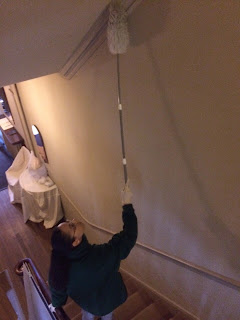It’s week two of our Winter conservation blog series, here to provide you with an insight into what happens behind the scenes at the Hardmans’ House. This week we’ll be finding out what our volunteers get up to during a normal Winter at 59 Rodney Street. I’ll be running through what’s been happening in the house regarding our conservation and cleaning regime...
 |
| Speke Hall, South Range |
Even before the house shut its doors at the start of November, a team of eager volunteers began an intensive two day training course in preventative conservation held at
Speke Hall. To ensure the safety of both the collection and our volunteers, it’s important that it’s not only new recruits that take part in the training. Even our most seasoned volunteers came along to refresh their skills ready for the Winter. This makes it a great opportunity for new volunteers to find out more about the property they’re going to be working in, and to meet their future co-workers. Items on the agenda include conservation cleaning, health and safety training, inventory checking, inventory marking, object condition reports and object handling – all of which have to be covered by the end of the two days.
 |
| A winter volunteer, Tatiana, gently dusts the stairwell |
Conservation cleaning is a little bit different to your average household clean. Its aim is not just to keep the objects dirt/dust free, but more importantly, to do as little damage to them as possible in the process. The equipment it uses may seem basic, but avoiding the use of modern chemical cleaners and scratchy materials is very important. We use soft pony hair brushes for delicate items and ceramics, and hogs hair brushes for more robust items such as pieces of furniture. The dust is swept into lint free cloths so that it doesn’t escape back into the room only to settle again. Specialist ‘museum vacs’ with controllable suction are often used for heavier dust, and for cleaning drapes and curtains.
 |
| A dedicated and steady handed volunteer inventory marking |
Inventory checking involves working through each item in the house, and using its unique reference number to determine whether it’s in its rightful place based on the inventory database. If an item doesn’t have a reference number, then it must go through the inventory marking process. This mark must be easily removable, so that it doesn’t damage the object, and it’s important that the right method is chosen. Here’s an example of a code that might be used for one of Mr Hardman’s cameras:
NT.ROD.SI.133
National Trust. Rodney Street. Scientific Instrument. Number 133
We can also use the code to look up whether the item has been given a condition report in the past. These reports are used to track the deterioration of each artefact over time, and also to provide a description of the object in case it is lost, stolen or accidentally damaged.
 |
| Matthew is busy inventory checking our Ground Floor Office |
For our new volunteers (myself included), your first Winter can be a bit of a learning curve! There’s a lot of new information to take in, and skills to be learnt, but there’s no denying it’s a very enjoyable experience. If becoming a Winter conservation volunteer sounds like something you’d be interested in, then
get in touch!
Megan Thrift
Winter Conservation Volunteer
The Hardmans' House


No comments:
Post a Comment